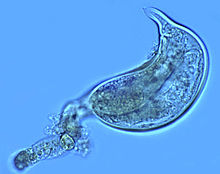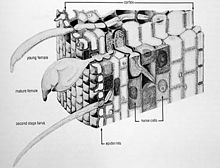- Tylenchulus semipenetrans
-
Citrus nematode 
Swollen female citrus nematode. Body of female is slightly crescent-shaped.
(Source: Nemaplex)Scientific classification Kingdom: Animalia Phylum: Nematoda Class: Secernentea Subclass: Diplogasteria Order: Tylenchida Superfamily: Criconematoidea Family: Tylenchulidae Subfamily: Tylenchulinae Genus: Tylenchulus Species: T. semipenetrans Binomial name Tylenchulus semipenetrans Tylenchulus semipenetrans (Citrus nematode, Citrus root nematode) is a plant pathogenic nematode. T. semipenetrans is found in most citrus production areas and diverse soil textures worldwide. Their feeding strategy is semi-endoparasitic nematode and has a very narrow host range among commonly grown crops. These nematodes are considered as major plant-parasitic nematode because they can cause 10-30% losses reported on citrus trees. They also parasitize other hosts such as olive, grape, persimmon and lilac. [1]
Contents
Morphology
T. semipenetrans is the only species of Tylenchulidae and these nematodes are economically importance to agriculture. Citrus nematode is 0.25-0.35 mm long. Procorpus and metacorpus amalgamated, distinct isthmus, postcorpus in bulb. They are distinct in juveniles. The larvae stage and male are wormlike. The male has reduced esophagus and stylet. The female citrus nematode is swollen, have single ovary, vulva subterminal, eggs deposited in matrix. It has a unique feature called excretory pore located at posterior end near the vulva of the swollen female. The pore surrounded by small, irregularly shaped lobes; excretory duct directed forward. Rectum and anus atrophied or absent; non-functional. [2]
Life cycle and reproduction
The life cycle of citrus nematode is 6-8 weeks long. These nematodes reproduce by amphiximis and parthenogenesis. The first-stage juvenile (J1) undergo one molt while still in the egg. J1 has no stylet. The second-stage juveniles (J2) hatch from the eggs and the sex can be distinguished at this stage. The J2 male is short and fat. They undergo molts before becoming adult males without feeding in 7 days. The citrus male nematode are required for reproduction with females that are exposed on the root surface. The J2 has a stylet while J3 and J4 have a weak stylet. The J2 female is longer and thinner than males and they do not molt until feeding site is established. The female juveniles begin feeding ectoparasitically on epidermal root cells. The young female is the infective stage of citrus nematode. The anterior end of the young female parasitizes suitable host roots and begin establish a feeding site after 7 days. After fertilization, the female lays its eggs outside of the root in a gelatinous matrix extruded from the posterior end of the female.
Host-parasite interaction
High population densities of the citrus nematode can result in severe damage on the citrus trees. Some above ground symptoms can be observed such as suppression of citrus tree growth, lack of vigor or decline symptoms, yellowing of foliage and small size of fruit. The young adult females penetrate into the cortex cells, become sedentary and form an enlarged ‘nurse’ cell. The posterior end of the female body stays outside the root. Some above ground symptoms can be observed such as suppression of citrus tree growth, lack of vigor or decline symptoms, yellowing of foliage and small size of fruit.
For below ground symptoms, the infected roots are thicker, darker, decayed and showed a dirty appearance because of large number of females is sticking on the infected roots. The infected root systems due to the nematode damage lose the ability to absorb enough water and nutrients for normal growth. Yellowing of foliage, leaf curling and dieback are consequences of insufficient root development and decayed young roots. [4]
According to Cohn 1969, 4000 juveniles/ g root are the damage threshold for slow decline disease in Israel. [5]. While in California, nematicide should be applied if more than 400 nematode females/ g root are sampled in February to April or 100 females/ g root in May and June. [6]. In Cyprus, the growers need to apply nematicides when the nematode densities reach 5000 juveniles/ 250 cm3 in soil.[7]. Treatments are recommended when 100 females/ g root are observed in South Africa. [8]. However, the age and vigor of the citrus trees, the nematode population densities in the soil, the aggressiveness of the nematodes, soil characteristics, and other environmental factors can influence the level of infestation by citrus nematode.
Management of the Citrus nematode
Management practices consist of exclusion and preventive measures. All growers should avoid contaminated nursery rootstocks and use certified nematode-free soil. For cultural practices, the container-grown citrus can be treated with steam and soil solarization. [9]. Fumigation and nematicides are used to reduced initial population densities. Halogenated hydro-carbons ( MBr,1-3-D and chloropicin) are the most effective. [10]. Resistant rootstocks are available and this management strategy is the most useful to suppress nematode population density. Recently, the hybrid rootstock called Swingle citrumelo (Citrus paradisi x P. trifoliata) is highly resistant to the citrus nematode. [11].
References
- ^ Verdejo-Lucas, S. and Mckenry, M.V. 2004. Management of the Citrus Nematode, Tylenchulus semipenetrans. Journal of Nematology 36: 424-432
- ^ http://www.ipm.ucdavis.edu
- ^ Verdejo-Lucas, S.,and D.T.Kaplan. 2002. The citrus nematode: Tylenchulus semipenetrans.Pp. 207-219 in J.L. Starr, R.Cook, and J.Bridge, eds. Plant resistance to parasitic nematodes. Wallingford, UK. CAB International.
- ^ Duncan, L.W., and E. Cohn. 1990. Nematode parasites of citrus. Pp. 321-346 in M.Luc, R.A. Sikora, and J.Bridge, eds. Plant-parasitic nematodes in subtropical and tropical agriculture. Wallingford, UK: CAB International.
- ^ Cohn, E. 1969. The citrus nematode, Tylenchulus semipenetrans Cobb, as a pest of citrus in Israel. Proceedings of the First International Citrus Symposium Vol.2: 1013-1017.
- ^ Westerdahl, B.B. 2000. Citrus nematodes. UC management guidelines for nematodes on citrus (http://www.ipm.ucdavis.edu).
- ^ Philis, J. 1989. Yield loss assessment caused by the citrus nematode Tylenchulus semipenetrans on Valencia oranges in Cyprus. Nematologia Mediterranea 17:5-6.
- ^ Le Roux, H.F.,M.C. Pretorius, and L.Huisman. 2000. Citrus nematode IPM in Southern Africa. Proceedings of the International Society of Citriculare Vol.2: 823-827.
- ^ Stapleton, J.J., C.L. Elmore, and J.E. DeVay. 2000. Solarization and biofumigation help disinfest soil. California Agriculture.54:42-45.
- ^ Sorribas, F.J. Verdejo-Lucas, M. Galeano, J. Pastor, and C.Ornat. 2003. Effect of 1,3-dichloropropene and rootstocks alone and in combination on Tylenchulus semipenetrans and citrus tree growth in a replant managenement program. Nematropica. 34: 149-158.
- ^ Kaplan, D.T., and J.H. O'Bannon. 1981. Evaluation and nature of citrus nematode resistance in Swingle citrumelo. Proceedings of the Florida State Horticultural Society. 94:22-36.
External links
Categories:- Agricultural pest nematodes
- Plant pathogens and diseases
- Nematode stubs
- Plant disease stubs
Wikimedia Foundation. 2010.





